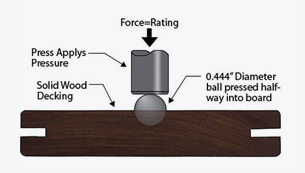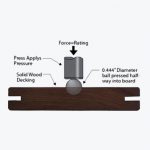You may have heard of this whole “Janka Hardness Test” business, but aren’t exactly sure what it is or what it means to you. No problem, we’ll try and help you out.
You should know that the Janka Hardness Test applies to both engineered wood flooring as well as solid wood flooring. Engineered wood floors typically feature a plywood base with a solid wood overlay, or “veneer”.
 So what exactly is the Janka Hardness Test? It’s quite simple. An 11.28 millimeter steel ball is forced halfway into various wood species to measure how resistant a species is. A rating is then applied to compare exactly how hard certain hardwood floors really are. A rating of 1290 is used as a baseline to see which woods are soft and which are hard. Ratings above 1290 are considered harder variants and those below 1290 are regarded as softer choices.
So what exactly is the Janka Hardness Test? It’s quite simple. An 11.28 millimeter steel ball is forced halfway into various wood species to measure how resistant a species is. A rating is then applied to compare exactly how hard certain hardwood floors really are. A rating of 1290 is used as a baseline to see which woods are soft and which are hard. Ratings above 1290 are considered harder variants and those below 1290 are regarded as softer choices.
What do these numbers mean to me?
The harder the wood, the more trauma it can take before it dents. Harder woods are more forgiving of careless mistakes. Harder woods are also forgiving of large pets and kids that roughhouse. Harder woods are better for heavier traffic scenarios but come with a downside: they don’t deal as well in dry climates and have the potential to split.
Ultimately, you want to choose the wood species that looks best to you, regardless of Janka ratings. If you like a certain type of hardwood because you believe it will match your home better or make it easier to work with, then that should be the one you pick. Also, it’s important to understand that the finish of a hardwood floor is the real defense against scratches and the like.
Read more about selecting a wood species here.


Leave A Reply